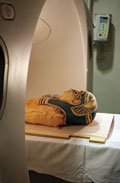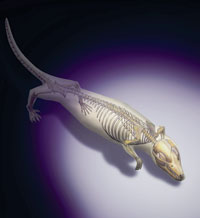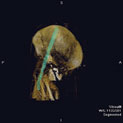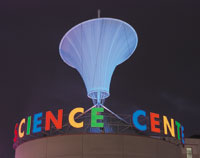 Summer 2007
Summer 2007|
By Leslie Vincen Portrait of the people Between 1936 and 1975, photographer Teenie Harris produced more than 80,000 black-and-white prints and negatives that today represent the largest and most complete portrait of African-American urban life in existence. The National Endowment for the Humanities recently awarded Carnegie Museum of Art a $348,885 grant for ongoing work to conserve, catalogue, digitize, and archive the collection. Between 1936 and 1975, photographer Teenie Harris produced more than 80,000 black-and-white prints and negatives that today represent the largest and most complete portrait of African-American urban life in existence. The National Endowment for the Humanities recently awarded Carnegie Museum of Art a $348,885 grant for ongoing work to conserve, catalogue, digitize, and archive the collection.
“It is critically important that his work be preserved and shared with future generations.”
Designing Women
Their efforts were underwritten by Lowe’s and, along with volunteer crews, produced a new house in the Hill District for a 36-year-old social worker and mother of two children. “Girls respond to science when it’s in context,” says Jennifer Stancil, executive director of Girls, Math & Science Partnership. “If we want to emphasize the importance of engineering as a career, we need to immerse girls in it. There is no better way to accomplish that than in a hands-on experience like working to build a real house.”
Listen closely ... you can hear a jaw drop
These ear bones of mammals and several jawbones of reptiles are developed from the same embryonic precursors. “Reptiles have a jaw full of ear bones from mammals and mammals have an ear full of jawbones of reptiles,” explains Zhe-Xi Luo, curator of vertebrate paleontology and acting co-director of Carnegie Museum of Natural History. But how the jawbones of reptiles became the middle ear of mammals have puzzled paleontologists and they scoured fossil records for signs of this transition. Finally, Luo and a team of researchers from China discovered one: Yanoconodon allini, a new tiny mammal—just five inches long—found in the Yan Mountains of Hebei Province in China. Yanoconodon’s stirrup, anvil, and hammer bones display the same layout as some mammal embryos do today. “Proportion of the ear bones in this animal is already like those of modern mammals, but their embryonic and reptile-like connection to the jaw is retained.” With its ability to pick up not only high frequencies but also vibrations transmitted through the ground, this extinct early mammal represents a key transitional step in the evolution of the exquisitely sensitive modern middle ear.
Mummy mystery still unraveling Researchers now know for certain that a 2,300-year-old mummy of an Egyptian child, on display at Carnegie Museum of Natural History for most of the last 50 years, was a boy. And, most likely, he was 3 years old and developing normally when he died, perhaps from an infection. Researchers now know for certain that a 2,300-year-old mummy of an Egyptian child, on display at Carnegie Museum of Natural History for most of the last 50 years, was a boy. And, most likely, he was 3 years old and developing normally when he died, perhaps from an infection.
They know after analyzing a digital dissection of the mummy, produced through a partnership with University of Pittsburgh School of Medicine and UPMC. On May 2, Carnegie Museum of Natural History Anthropologist Sandra Olsen joined radiologists at UPMC to perform a CT scan of the tiny mummy. Prior to the scan, museum researchers only had access to X-rays of the mummy taken in the 1940s and 1986, and had thought the child, whose sex was unknown, was about 8 years old with an unusually large head, suggesting that a genetic condition might have contributed to his death.
“From an archaeologist’s point of view, we now know this little fellow inside and out,” says Olsen. And soon, we’ll all know even more. Researchers are manipulating the 1,700 images taken during the scan to develop a skin rendering and a three-dimensional computer image of the boy’s head for both exhibit and study. Olsen says the profile of the boy’s nose and ears are fairly intact. And the scan makes it possible to develop an exact resin cast of the child’s skull, which an artist will then use for facial reconstruction. “What I dream of one day is having a complete reconstruction of him on exhibit playing the Egyptian game Senet,” says Olsen. What will happen soon, for sure, is visitors to Walton Hall of Ancient Egypt will be able to view scans of the mummy, with the ability to rotate three-dimensional images.
$1.4 million in the name of science
The Bozzone family gift has helped raise the total of the Building the Future campaign for Carnegie Museums of Pittsburgh to more than $133.2 million. About the staff at the Science Center, Bozzone notes, “They make science relevant and fun, and then they take it on the road, touching countless children. You can’t put a dollar figure on that.” Dollars definitely help the cause, though, and Bozzone’s first campaign pledge of $400,000 helped the Science Center create its first new show for the Buhl Digital Dome, called A Traveler’s Guide to Mars, which premiered on May 12. The Buhl Digital Dome is the renamed Buhl Planetarium, which now features a high-definition, full-dome experience with bells and whistles that include regular image downlinks from NASA and the ability to show those images in real-time. “The Buhl Digital Dome is the kind of thing that intrigues kids and gets them interested in science, space, and technology,” says Bozzone, who is a member of the Science Center board and a trustee of Carnegie Museums of Pittsburgh. An unrestricted gift of |
Pittsburgh Glass · Time to Play · A New, More Personal Jesus · Mars Comes to Pittsburgh · Special Supplement: Thanks to Our Donors · Director's Note · Now Showing · Face Time: Anthony Rothbauer · About Town: Art Imitating Life · Field Trip: On the Road with Douglas Fogle · Science & Nature: Working the Bones · Artistic License: The Traveling Factory · First Person: A Traveler's Diary · Another Look: Sol LeWitt Drawings
 |
Copyright © 2017 CARNEGIE Magazine. All rights reserved. |

 Women may be from Venus and men from Mars, but at Carnegie Science Center, science is brought down to Earth for everyone—girls and boys alike. This spring, young women from the Girls, Math & Science Partnership spent National Engineers Week learning hands-on science in the Hill District, as part of the Women Build project from Habitat for Humanity.
Women may be from Venus and men from Mars, but at Carnegie Science Center, science is brought down to Earth for everyone—girls and boys alike. This spring, young women from the Girls, Math & Science Partnership spent National Engineers Week learning hands-on science in the Hill District, as part of the Women Build project from Habitat for Humanity. 
 The boy’s missing right front tooth had caused much debate, because its loss made it appear that the boy was aged 5 or 6 years, says Olsen. However, the CT image showed that it had probably dislodged during transport of the mummy. The absence of molar roots defined the child’s age at just 3 years. Closer examination also revealed a large hole in the back of the boy’s skull, believed to have been made during preparation of his remains. During mummification, it’s common to remove several organs, and typically the brain is taken out through a nostril. But Olsen says the child’s brain was probably too large to remove in pieces through the tiny hole made in the nasal cavity, so instead it was taken out through the base of the skull. This large hole explains why a long papyrus rod had been inserted into the skull and through the upper spine to support the boy’s head.
The boy’s missing right front tooth had caused much debate, because its loss made it appear that the boy was aged 5 or 6 years, says Olsen. However, the CT image showed that it had probably dislodged during transport of the mummy. The absence of molar roots defined the child’s age at just 3 years. Closer examination also revealed a large hole in the back of the boy’s skull, believed to have been made during preparation of his remains. During mummification, it’s common to remove several organs, and typically the brain is taken out through a nostril. But Olsen says the child’s brain was probably too large to remove in pieces through the tiny hole made in the nasal cavity, so instead it was taken out through the base of the skull. This large hole explains why a long papyrus rod had been inserted into the skull and through the upper spine to support the boy’s head. Pittsburgh business leader Bob Bozzone, an engineer by training and a longtime leader at Allegheny Technologies, Inc., says the future’s all about “technology, technology, technology.” So when Bozzone decided to make a $1.4 million gift to the Building the Future campaign on behalf of his wife, Irene, and the Bozzone Family Foundation, he focused on the Science Center, where science, technology, and fun converge in a way that gets kids thinking about futures in science.
Pittsburgh business leader Bob Bozzone, an engineer by training and a longtime leader at Allegheny Technologies, Inc., says the future’s all about “technology, technology, technology.” So when Bozzone decided to make a $1.4 million gift to the Building the Future campaign on behalf of his wife, Irene, and the Bozzone Family Foundation, he focused on the Science Center, where science, technology, and fun converge in a way that gets kids thinking about futures in science.